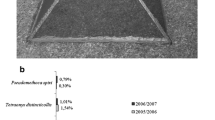Summary
The winter cherry bug,Acanthocoris sordidus Thunberg, lives in aggregation especially in their early larval instars. Using the 1st-instar larvae of this species, the author tried to clarify both the processes and the mechanisms of the breakup and later re-formation of colony in relation to the defence against their enemies. The results obtained were summarized as follows.
-
(1)
In the field population, there is a high possibility of dispersal of the 1st-instar larvae from a colony possibly through the disturbance by some predators but they can re-form a colony with each other or join, with colonies of different instar larvae.
-
(2)
The individuals in a colony immediately disperse through the attack of predatory coccinellid beetle,Harmonica axyridis but tend to re-form a colony in a short time.
-
(3)
The breakup of colony is caused by the secretion from the attacked individual.
-
(4)
The formation of colony is attributed to the habit closely related with the senses of smell and/or contact.
From these results, it was concluded that the dispersal of 1st-instar larvae from a colony, followed by the re-formation of a colony, is an an adaptive behaviour to escape from the attack by their predators.
Similar content being viewed by others
References
Calam, D. H. andA. Youdeowei (1968) Identification and functions of secretion from the posterior scent of fifth instar larva of the bug,Dysdercus intermedius.J. Insect Physiol. 14: 1147.
Dempster, J. P. (1971) The population ecology of the cinnabar moth,Tyria jacobaeae L. (Lepidoptera, Arctiidae).Oecologia 7: 26–67.
Dixon, A. F. G. andS. McKay (1970) Aggregation in the sycamore aphid,Drepanosiphum platanoides (Schr.) (Hemiptera: Aphidae) and its relevance to the regulation of population growth.J. Anim. Ecol. 39: 439–454.
Dixon, A. F. G. andM. Logan (1972) Population density and spacing in the sycamore aphid,Drepanosiphum platanoides (Schr.), and its relevance to the regulation of population growth.J. Anim. Ecol. 41: 751–759.
Fujisaki, K. (1973) The spatial ditribution pattern of the winter cherry bug,Acanthocoris sordidus Thunberg, in relation to its aggregation behaviour.Jap. J. appl. Ent. Zool. 17: 31–38. (In Japanese with English summary.)
Ishiwatari, T. (1974) Studies on the scent of stink bugs (Hemiptera: Pentatomidae) I. Alarm pheromone activity.Appl. Ent. Zool. 9: 153–158.
Itô, Y. andK. Miyashita (1968) Biology ofHyphantria cunea Druly (Lepidoptera: Arctiidae) in Japan. V. Preliminary life tables and mortality data in urvan areas.Res. Popul. Ecol. 10: 177–209.
Iwao, S. (1967) Some effects of grouping in Lepidopterous insects; L’effet de groupe chez les animaux. Colloques internationaux du centre national de la recherche scentifique.173: 185–212.
Iwao, S. andE. Kuno (1971) An approach to the analysis of aggregation pattern in biological populations. Statistical ecology Vol. 1 (Eds.G. P. Patil et al.) Pennsylvania Univ. Press, University Park and London pp. 461–513.
Kiritani, K. (1964) The effect of colony size upon the survival of larvae of the southern green stink bug,Nezara viridula.Jap. J. appl. Ent. Zool. 8: 45–54.
Kiritani, K. andK. Kimura (1966) A study on the nymphal aggregation of the cabbage stink bug,Eurydema rugosum Motschulsky (Heteroptera: Pentatomidae).Appl. Ent. Zool. 1: 21–28.
Kiritani, K andN. Hokyo (1970) Studies on the population ecology of the southern green stink bug,Nezara viridula L.Agriculture, Forest and Fisheries Research Council. Rept. Special Project 9: 260 pp. (In Japanese.)
Lloyd, M. (1967) ‘Mean crowding’.J. Anim. Ecol. 36: 1–30.
Nakasuji, F., H. Yamanaka andK. Kiritani (1973) The disturbing effect of micryphantid spiders on the larval aggregation of the tobacco cutworm,Spodoptera litura (Lepidoptera: Noctuidae).Kontyû. 41: 220–227.
Author information
Authors and Affiliations
Rights and permissions
About this article
Cite this article
Fujisaki, K. Breakup and re-formation of colony in the first-instar larvae of the winter cherry bug,Acanthocoris sordidus thunberg (Hemiptera: Coreidae), in relation to the defence against their enemies. Res Popul Ecol 16, 252–264 (1975). https://doi.org/10.1007/BF02511065
Issue Date:
DOI: https://doi.org/10.1007/BF02511065




